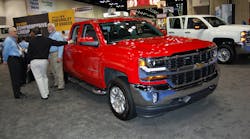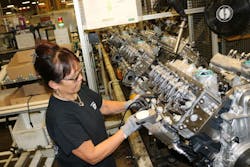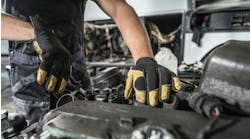John Schwegman will tell that while demand for greater fuel economy “has always been important and will stay that way” for light- and medium-duty units “work truck” roles, the desire now is for more options and more overall “functionality” when it comes to vocational-focused platforms.
Schwegman, U.S. director of commercial product and medium duty for the General Motors fleet division, explained to Fleet Owner during an interview at the 2017 NTEA Work Truck Show, that the focus on the segment is now turning to delivering more focused products to “fill up the series of niches” in the work truck space.
“These fleets don’t want a lot of frills but they do want functionality,” he stressed. “They don’t want leather interiors or chrome but they do want safety features such as collision mitigation and automatic emergency braking (AEB) systems. There is a definite trend towards a willingness to pay for them.”
As a result, he said Chevrolet is crafting mid-level and base-level packages that incorporate such safety technology. “They’ve become very popular [systems] across the work truck buyer spectrum; we’ve heard that loud and clear,” Schwegman noted.
Yet “functionality” also revolves around getting more vocational truck options as well, he emphasized – especially when it comes to powertrains.
That’s one reason why GM went into partnership with Navistar to build a new Class 4-5 conventional commercial truck due to launch next year, he said – one that will be offered with GM’s Duramax diesel engine mated to an Allison Transmission automatic gearbox by the second half of 2018.
“This is another opportunity to bring higher fuel efficiency together with more performance in this segment,” Schwegman pointed out. “It offers the low-end torque the work truck side of the business wants and is also 100% rated to run on B20 biodiesel fuel.”
GM is also moving to offer more “hardened” engines in this space as well that can run on 100% compress natural gas (CNG) or propane or on some “bi-fuel” mixture of CNG and gasoline if desire.
On another front, GM’s recent introduction of a Class 6 low cab forward model – the 6500XD – expands its lineup of cabover Class 3-5 medium-duty trucks built in partnership with Isuzu Commercial Truck.
The key to the 6500 XD is it’s just under 26,000 lbs., so it doesn’t require a commercial driver’s license to operate.
“Now we will have models across the work truck spectrum: pickups, vans, medium-duty conventionals and cabovers,” Schwegman explained. “Now our customers can go to one dealer, one OEM, for all of their work truck needs. It allows them to ‘hit the easy button’ where their truck needs are concerned.”
Having both medium-duty conventional and cabover or “tilt cab” models on hand also fulfills the “functionality” role, too, as each brings specific performance advantages to the work truck table.
Schwegman said sales of “tilt cabs” track around 20,000 to 25,000 units per year, with 80% of them focused on pickup and delivery operations in metropolitan markets where turning radius is vital. “Our low cab forward trucks have an incredibly tight turning radius; one equal to a Chevy Sonic,” which is one of Chevrolet’s most compact of cars, he pointed out.
But conventional models, which see sales of 50,000 to 60,000 units annually, offer higher ground clearance in both on- and off-road operation and are a better fit for more rough-and-tumble work for landscapers, utility fleets, and in the oil fields.
The final piece of “functionality” revolves around communication links and truck telematics.Again, Schwegman sees a “divergence” among buyers as to what level of communication and vehicle data analysis they desire, but the demand for it is there among all of them.
“We’ve got OnStar available across 98% of our platforms; it’s embedded into the vehicles for customers to use if they so choose,” he said.
“So what we’re doing now is developing ‘cheaper’ communication packages for crash notification, emergency response, and route monitoring – that gives fleets an ‘easy button’ for basic services,” Schwegman explained.
“But for those that want to dive deeper into telematics and data analysis customized to a particular fleet, we offer services through our partners Telogis and Spireon,” he said. “The whole point is this: it’s built in, so if you want it, it’s there; you don’t need to buy a system and install it. But if you don’t want it, no worries; you don’t have to use it.”






